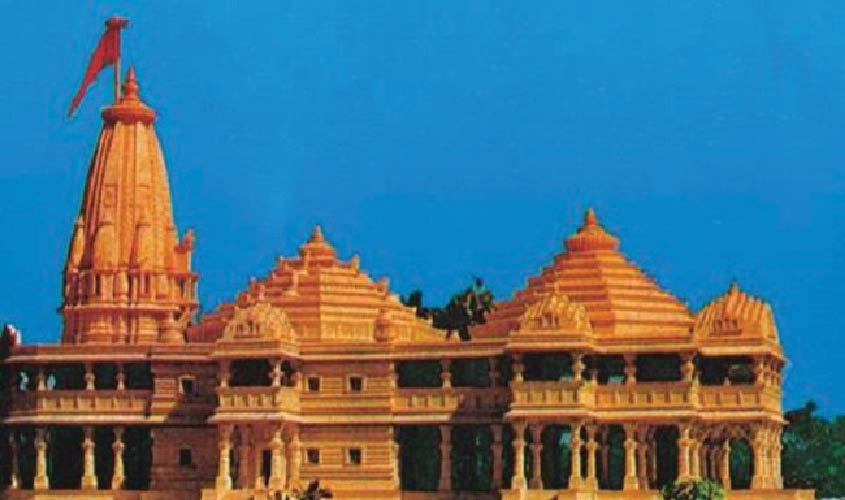The Bhoomi Pujan to mark the commencement of the Ram Temple construction at Ayodhya was indeed a historic moment, and should be viewed as the cumulative culmination of the long-standing desire of the majority of Hindus to be able to worship where they believe Lord Ram was born. In fact, the Bharatiya Janata Party’s rise in national politics was directly linked to its public commitment to build a temple in the holy town on the banks of the Saryu river. “Kasam Ram ki Khate Hain, Mandir Wahin Banayege”, was the slogan which caught everyone’s attention, as Lal Krishna Advani embarked on his Somnath to Ayodhya Rath Yatra, in August-September 1990, to offset the Mandal movement, unleashed by an insecure V.P. Singh, so as to save his Prime Ministership.
The Rath Yatra, where Pramod Mahajan acted as Advani’s charioteer, was the BJP stalwart’s personal decision, without having the sanction of the RSS. However, the objective of the Yatra was to prevent Hindu society from fragmenting on caste lines, and was in conformity with the RSS thesis that the only way of bridging caste differences was to highlight Hindu sentiments.
It took 30 long years for the BJP to fulfil this pledge to the people, and when Prime Minister Narendra Modi prostrated on the ground, to pay obeisance to the idol of the deity, the strong emotional quotient embedded in the movement came to fore, with virtually the whole country celebrating the occasion.
The Congress, the principal opposition party, was quick to realise the futility of opposing the Bhoomi Pujan, and welcomed the beginning of the construction of a grand Ram Temple. Priyanka Gandhi Vadra enthusiastically voiced her support, while former Madhya Pradesh Chief Minister, Kamal Nath, organised the recital of Hanuman Chalisa at his residence in Bhopal, to associate himself with the ceremony. He had earlier stated that it was Prime Minister Rajiv Gandhi, who had made this day possible, as it was during his tenure that the locks to the Mandir site were unlocked. Subsequently, the shilanyas was performed as he launched his election campaign in 1989 from Ayodhya/Faizabad, with the promise of ushering in Ram Rajya.
There are many analysts who are of the opinion that before the 2019 Parliamentary polls, Rahul Gandhi should have focused on his father’s role in the controversial and contentious political issue, which would have possibly assured the electorate, that if the Congress returned to power, it would build the Ram Temple in Ayodhya, thereby preventing the BJP to be its sole advocate. After all, this would have been in conformity with the soft Hindutva line the Congress had adopted.
The Bhoomi Pujan has, for no rhyme or reason, triggered off a debate on TV channels between secularists and Hindutva supporters. Such a face-off is absolutely superfluous, being devoid of any logic. It pre-supposes that secularists are pro-minority and thus, are opposed to anything that is to do with the majority community. It goes without saying that true secularism implies equal respect for all religions. Therefore, it is fallacious to suggest that in order to be seen as progressive, secularists should run down the religion of the majority.
They must learn from the blunders made by the Congress during the UPA period, when the party abandoned its secular stance and tilted towards the minorities, thereby allowing the BJP to strengthen the perception that it was anti-Hindu. The rest is history. The Balraj Madhok doctrine, reiterated by top BJP leaders, prominently by Advani, holds as true now as it did then. India is secular, primarily because it is a Hindu dominated country. It is also a functioning democracy because of its unique character—Hindu pre-eminence while enfolding other religions. In the early 1990s, Advani’s response to a BBC journalist, who asked him if India was heading towards a Hindu Rashtra was most aptly befitting. Advani retorted that India was a Hindu country in the same manner as Britain was a Christian country; just as in Britain, where people of all faiths lived and co-existed harmoniously, so was the case in India.
It is a well-known fact that the BJP has grown from strength to strength, primarily because it identified with matters which it considered core to Hindu society. The party and its affiliates benefitted immensely from contrary positions taken by its opponents, primarily the Congress, and ultimately managed to acquire power through the democratic process.
The Mandir movement had touched, more or less, a collective chord. There were dissenting voices which did not approve of the methods that the BJP was employing to attain its objective, yet at the same time, wanted a temple in Ayodhya. The Congress discounted the well-considered theory of Jeremy Bentham and John Stuart Mills, Liberals from the Utilitarian Tradition.
Bentham and Mill had espoused the cause of greatest happiness for the greatest number, and in the Indian context of the 21st century, this is what was applicable. The largest numbers wanted a temple in Ayodhya, though many condemned the illegal demolition of the mosque that stood at the site.
The Bhoomi Pujan is a high point in Modi’s political career and for BJP it is the path for actualising its belief in the politics of Hindutva. The issue has, for once and all, been settled, and anyone who dares oppose the construction of the temple, is bound to encounter the wrath of the common man. It is now time to move towards nation building. Between us.

